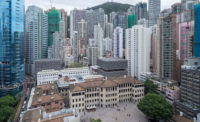Atelier Z+
Shanghai, China
Set in the southeast corner of Tongji University, the Sino-French Centre fits into a dense campus fabric that has developed since the university was founded in 1907. With its east side facing busy Siping Road, its north almost touching the existing Xuri Pavilion, and its west addressing the Monument of Martyrs and a large classroom building, the Centre must negotiate a number of different conditions. In addition, the university wanted to preserve many of the beautiful trees on the site. Atelier Z+, a young Shanghai firm established in 2002 by Zhang Bin and Zhou Wei, responded to these challenges by designing a building that zig-zags its way around the site, creating outdoor spaces that weave trees and neighboring buildings into its sphere of influence without overpowering them
Inspired by the mission of the centre to promote cooperation and cultural exchange between China and France, Atelier Z+ developed a “hand-in-hand” scheme that juxtaposes forms, materials, and functions. Instead of blurring or masking differences, the architects celebrated them. In doing so, they created a centre that reads as two buildings—one clad in Cor-ten steel and the other in precoated cement panels, one with a sharply angled profile, the other with a flat roof. The rusting orange wing houses mostly college classrooms and lecture halls, while the gray-cement wing provides space mostly for offices.
The college sector with its angled Cor-ten envelope has a more dramatic personality than the gray-suited office sector, as if to say that the process of learning is the star here and the administrative function plays a supporting role. Inside, the college sector is more colorful too, its public spaces wrapped in rich shiny wood that has a warm, orange glow. Zhang Bin and Zhou Wei injected another note of visual excitement here by attaching conical volumes to several of the classrooms, designing sensual forms that reach up to the roof and bring daylight inside. Clad in the same rich wood as the rest of the college interior, the cones recall Richard Roger’s design for the Bordeaux Law Courts in France, though done on a smaller scale and budget. The architects also created a curving steel stair for the college sector, adding yet another expressionistic element to the vibrant mix of forms and color. The office sector, on the other hand, is more subdued, with white walls, simple materials, and cleanly detailed fenestration.
Where the two sectors come together, Atelier z+ created a pair of memorable spaces that combine indoors and out: a partially covered sunken garden on the basement level and a reflecting pool one floor above. An exhibition hall and a café flank the sunken garden, creating a suite of public spaces shared by everyone at the centre.
Landscape design plays an important part in the building’s success. Not only did the architects preserve many trees growing on the site, but they oriented their building to work with an existing Memorial Park that includes the Martyrs Monument. With the Sino-French Centre defining a new edge for the park, the architects expect this outdoor space to assume a more important social function for the entire campus.









